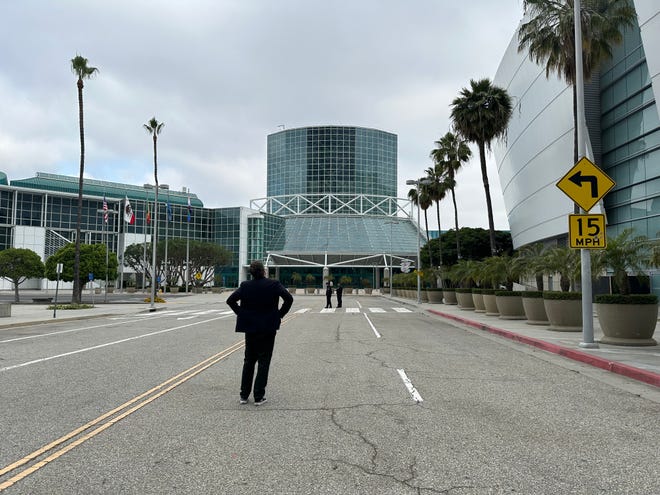The life and death of E3
The story of the world's most chaotic trade show, told by the people who were there
In the beginning, it was about respect.
The video games industry in the 1990s didn't get any. Tom Kalinskie, who led Sega America during this time, recounts two stories that sums up the world's attitude towards gaming.
The first came about during the famous 1993 – 1994 US senate hearings around violent video games. Kalinskie had been called in by his own senators to talk about the issue, and he explained how games are not just for kids.
"They scoffed," he recalled. "They couldn't believe it. "Are you kidding me? Everyone knows video games are just children's products. You shouldn't be doing these aggressive things'. And they basically tossed me out of their offices in DC."
Later on, Kalinskie visited Jack Valenti, the head of the Motion Pictures Association, to ask if video games could use the same age ratings system as the film industry, especially as everyone was so familiar with it. Valenti refused. He didn't understand why the huge movie industry would lend the tiny games industry its rating system.
US Government scrutiny over violent video games is what ultimately led to the formation of the Interactive Digital Software Association (today called the Entertainment Software Association), a dedicated trade body set up by the games industry, initially, to create a ratings system for games (and thus avoiding any Government legislation). The games industry had finally unified, and it was through this new organization that it would start to push back. Part of that, it became apparent, was having its own event to showcase the medium.
Back in 1994, the games industry would descend upon the Consumer Electronics Show in Las Vegas to showcase its games and consoles to retailers and media.
"CES didn't care a jot about video games"
Tom Kalinskie, former Sega US boss
"CES didn't care a jot about video games," recalls Kalinskie.
"It was bad enough they used to put us at the back of the big hall, but one year they put us out the back door under a large tent. You had to walk past all the porn sections to get to us. It rained that year in Las Vegas, and there was a leak over the Sega area and water dripped on my Sega Genesis consoles. And I said: 'That's it, we're never doing this again, we will do our own show.'"
The games industry tried to negotiate with CES to improve how video games were being represented, but to no avail. So the IDSA partnered with the International Data Group, an organisation that ran the GamePro magazine and the Macworld conventions, to build out a dedicated video games trade show. CES made a last ditch effort to counter the event, but the damage was done. E3 was born.
"Gary Shapiro [head of the Consumer Technology Association, which ran CES] called it Black Thursday, because everyone was faxing in their CES cancellations every half an hour," remembers Mary Dolaher, who effectively ran E3 from its inception until its final physical show in 2019.
Peter Moore, who exhibited at E3 from 1999 with Sega, Microsoft and then EA, adds: "We were craving attention and relevance. We were much maligned as a medium by Hollywood, by TV, by music. I testified in front of the senate on behalf of video games in 2000, and games were seen as the root of all evil. I always remember 'Call of Duty killer' headlines in the UK. Video games were an easy target. I was involved, working with the ESA and the industry, in building out this tentpole moment to say 'Look at us. Look at what we're doing for entertainment'."
The first E3 in 1995 may not have been as excessive as the years that followed, but it was a dramatic and competitive event. Nintendo, Sony and Sega were all there demonstrating their new consoles: The Ultra 64, PlayStation and Sega Saturn. Nintendo's console was still a year away, so all eyes were on Sony and Sega and their CD-based machines.
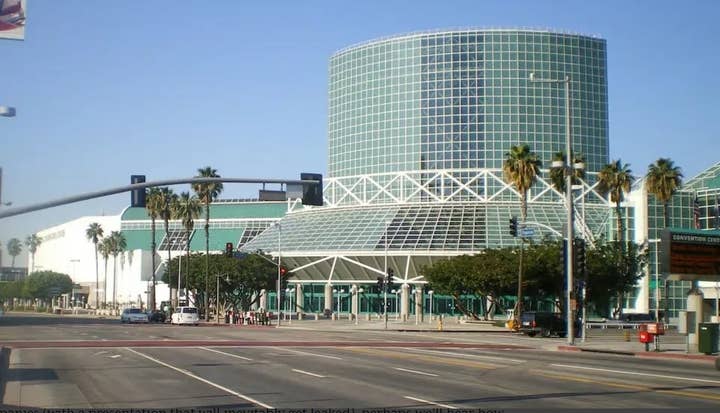
Sega was hugely popular in the US at the time, but there were concerns around the Saturn's technical capabilities, and there was significant buzz around Sony's machine. So Sega made the decision to surprise launch the Saturn during E3 – four months earlier than planned – and get ahead of its new rival.
"I was not in love with the Saturn architecture, and my head of R&D, Joe Miller, wasn't either," Kalinskie tells us. "We felt it needed to be a bigger step-up than it was. And then I was forced to introduce it at that E3, and I really didn't want to. I had three titles, maybe, I didn't have enough hardware. But Japan forced me to do it."
Sony countered with a surprise of its own. PlayStation's US boss Steve Race took to the stage and simply said '299'. It was a killer punch. Sony's console would be $100 cheaper than Sega's.
"Ah, the shortest speech in E3 history," laughs Race. "Right up until that morning we were still debating the price. We were wrestling with the Japanese to get to that magic $299 price point. I have no idea what I'd have said if they'd insisted on $399. As you could tell, I didn't have a speech prepared for that situation."
The console war battleground
From that moment on, E3 became synonymous with platform battles, as the major hardware manufacturers fought it out in Downtown LA.
"E3 was the battleground for the console war," recalls Moore.
"The question of 'Who won E3?' was always what people wanted to know. Who had the best press conferences? Who had the most engaging content? Who had the biggest crowds? It was fighting and scrapping for the leadership position in an industry that was growing exponentially. E3 was both the battleground as well as the canvas on which we painted our industry."
"In the old days it was Wild West, it was what you could get away with and still get gamers to believe you were showing them real games."
Peter Moore, former Sega, Xbox and EA exec
Moore's first taste of the console war was when the Sega Dreamcast went toe-to-toe with PlayStation 2, and it was a bruising encounter.
"My fight with PlayStation goes back to the Sega days, when Sony just FUDed us… putting 'fear, uncertainty and doubt' in the minds of the gamer," Moore explains.
"Go look at Kessen and The Bouncer. Those were PS2 games that went up against us. They were cinematics. They certainly weren't gameplay, and probably weren't even in-engine. Even 24 years later, I still remember those games. I was a layman at the time. I was just some shoe guy from Reebok who had been dropped into the video game industry. And I was thinking: 'There is no way these games will look like that'. In those days you could get away with that because there was less scrutiny from media and regulators. Now, the FTC has got involved to tell people to be honest with what they're showing. But in the old days it was Wild West, it was what you could get away with and still get gamers to believe you were showing them real games."
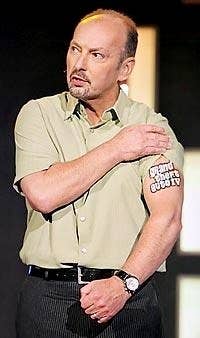
Moore got a second crack at PlayStation when he switched to Microsoft and launched the Xbox 360, and this time he was ready.
"They tried to FUD us with PS3, but that just didn't work. The pricing was wrong… we had our challenges, like the Red Ring of Death, but we got out ahead of them.
"It was a real battle. If you go back and see me with a Halo 2 tattoo, or later a GTA 4 tattoo… I was just sticking it to PlayStation with a bit of Scouse in-your-face aggression. PlayStation came up with a trailer for Killzone that was just total bullshit, and we knew it. They knew they needed to counter-punch, because we were ahead of them in terms of the Xbox 360 launch. So they created a movie and alluded that it was how the game would look, which of course it didn't."
The PS3 era was a low point in Sony's storied history with E3. Shawn Layden, who held numerous leadership roles at PlayStation, recalls the calamitous E3 press event in 2006 where PS3 was revealed.
"We were setting up the stage, and then all of a sudden everything crashed. We had engineers there, we were rebooting, we were updating code in real time to make sure these things were running. We ended up making people wait for over two hours outside in the Southern Californian heat for the PlayStation 3 press conference, because we couldn't stabilise the code on stage.
"And then later on when we announced that PlayStation 3 was going to be available for the low, low price of $599 for the 60GB version. And the massive groan that went around the room. I have a lot of hard memories around the PS3 years at E3."
Nintendo has largely separated itself from the console war these days, but it certainly enjoyed getting one over its rivals at E3. And whereas 2006 may have been an event to forget for Sony, it was quite the opposite for Nintendo.
"I remembered a sea of people running through Sony's booth to get into line to try the Wii"
Rob Matthews, former Nintendo and Xbox exec
"We were launching Wii and didn't know how it was going to go," recalls Rob Matthews, who was Nintendo’s head of consumer marketing at the time.
"The main way you came into the E3 hall meant that people had to walk around Sony's booth to get to ours. I was there on the upper deck as the doors opened, and I remembered a sea of people running through Sony's booth to get into line to try the Wii for the first time. I was like 'Wow. We've got something special here'."
"That was true," agrees Perrin Kaplan, who was Nintendo's VP of marketing and corporate affairs and now co-runs PR agency Zebra Partners. Our booths were next to each other, and people just cut through. We had a line that was wrapped twice around what was a very large booth. [Wii] was absolutely industry-shifting and it was neat to be part of that."
E3 was a competitive show. Rivals openly ridiculed each other (who could forget Sony's video mocking Xbox One's game sharing options in 2013?), and there were even stories of sabotage (Kalinskie claims Sony deflated his giant Sonic balloon in 1995). And that competitiveness played out in the halls of E3, where Nintendo, PlayStation and Xbox could be found side-by-side.
"It was cool when all the big three were in the same hall together," says Matthews, who later left Nintendo to join Xbox and was responsible for the firm’s E3 efforts.
"It kept us all on our toes. Xbox was inevitably always right next to Sony. I remember our big green glowing wall next to their big blue glowing wall. And there is that famous picture of right down the hall with the two logos facing off.
"We were frenemies for that whole endeavour. We were doing something for the bigger cause of video games around the world. If you look at the smaller brands, and the accessory brands and the companies who wouldn't normally be able to make a dent in their marketing if it wasn't for the big three or four putting them on stage... We would compete vigorously with each other all throughout the year, but we also realised that we were all in the same small industry and doing something special."
.png?width=720&quality=70&format=jpg&auto=webp)
Making E3 PG-13
After E3's debut year, the event went into overdrive. Companies were fighting over space in the halls, the parties got bigger and the costs just kept on going up and up.
"The excesses were always excessive," Layden remembers of the early E3s.
"The two years at Atlanta, Georgia were crazy years [E3 temporarily left the Los Angeles Convention Center in 1997 and 1998 due to building work]. The industry was making a lot of money. Back then, Tomb Raider was the biggest thing in the world and there was this huge party, which was as crazy and debauched as you might imagine. But that was the industry. We were becoming really successful. It was an industry coming out of mum's basement."
This level of success attracted unwanted attention. The E3 organisers had to adopt increasingly more stringent vetting processes to prevent undesirable companies getting in. Businesses would claim to have a game only to turn out to be something else entirely (such as a talent agency promoting models).
E3 also reflected the young, male-dominated nature of the industry at the time. Female models wearing revealing outfits were commonplace. In 2003, Nokia even announced the price of its N-Gage games phone by having a model remove her top to reveal the price on her stomach. And things would go even further on the E3 show floor.
"Each year the exhibitors would push the envelope a bit further in trying to get attention," Dolaher says. "One particular company had booked a small 10x10 booth, and they had a woman who would strip down to basically nothing. We had ESA members come to us and say 'If this is what companies need to do to sell their game, then maybe they shouldn't be on the show floor'."
The offending company refused to leave the show when asked, so Dolaher shut off the booth's power. In protest, the company tried to auction the model's underwear online, prompting the E3 organiser to go even further.
"I shrink wrapped them," she laughs. "We got huge rolls of plastic wrap and we covered the entire booth. We left the top open because he refused to leave. I said 'Okay, I'll leave you some air'. It was hysterical."
"One particular company had booked a small booth, and they had a woman who would strip down to basically nothing"
Mary Dolaher, E3 organiser
The incident prompted a change in the rules over what was acceptable attire at E3.
"We worked with all the member companies and asked them what they thought was appropriate and how they wanted us to write the rules. I called everyone in the event industry that I knew. Most didn't have it as bad as us. It was over-the-top. We decided that everyone had to show us their uniforms and costumes in advance for approval
"Then we would do the searches on the show floor. It was very labour-intensive, but it was worth it. We just made the event PG-13. Dresses had to be X amount of inches, and shorts couldn't be worn, and no thongs and things like that. It seemed crazy at the time… but I tell you, the death threats I was getting were awful.
"People were saying I was an old ugly b*** who probably drives a minivan. And I was like 'Hey, I draw a line at minivan'."
The Santa Monica experiment
E3’s goal of attracting mainstream attention was succeeding. Politicians and celebrities would make appearances at the event, and this brought in all sorts of media to the show.
"In the mid-2000s, it was the mainstream, popular TV channels, the likes of CNN, CBS, ABC, NBC… they would send film crews and correspondents to E3," Moore says. "And that gave us that sense of relevance and deserved acclaim in what we were doing."
However, as E3 got bigger, noisier and more expensive, ESA members started to become dissatisfied. With 60,000 people descending upon the LA Convention Center, it was proving harder to get actual business done, and the industry insisted things had to change. This led to the creation of the E3 Media & Business Summit. Between 2007 and 2008, E3 was capped to just 5,000 people in a hangar in Santa Monica, with various press events held in hotels around the area. It was a logistical nightmare (there were very few places to park trucks), and despite the smaller size, remained expensive to produce.

"It was a disaster," recalls Moore.
Dolaher adds: "There was no pizazz, none of that big stuff you did with the media. And the industry felt it."
Despite it being a clear low point in E3's story, Dolaher credits the Santa Monica experiment as effectively saving the show.
"This happened during a time of transition in ESA leadership, and luckily, we were able to convince the Board to downsize the show instead of discontinuing it altogether. It was a huge challenge logistically, but in the end it kept E3 alive long enough for it to come back later at full force. In 2009 we reinvented the show back in Downtown LA and launched with 41,000 attendees."
The famous faces of E3
The excess soon returned. E3 was the games industry’s Hollywood event. In fact, part of the reason the event was held in LA was to attract the attention of the wider entertainment world, and it worked, with actors, athletes and musicians making regular appearances.
Most people we spoke to had a celebrity story of some description. Leon Winkler, who ran Ubisoft's E3 showing from 2014 onwards, recalls the surreal moment he pitched E3 to It's Always Sunny star Rob McElhenney (to promote his Ubisoft-backed sitcom Mythic Quest), and the time he shared a cigarette with Elijah Wood.
"We talked about his work and his time in Amsterdam when he did Amsterdam things. It's these human moments that create the memories," Winkler says.

Moore was frequently paired on stage with sports stars, or tasked with guiding Steven Spielberg around his booth.
"One of my favourite memories was being with Mohammed Ali backstage," Moore begins.
"That was during my Xbox days. EA Sports was coming hard on the platform. And because of games like Fight Night and Knockout Kings, we managed to get Mohammed to come with us. He was, unfortunately, well into his Parkinsons then. My job for a few minutes was to look after him, if you will, just off stage. There was this screen with what we were showing, and Halo was on it. And in it there was Master Chief taking down a Brute. The Brute then goes down with a crash. Mohammed couldn't speak other than a slight whisper, and his way of communicating was via little magic tricks, which were wonderful. But at that moment he leaned over to me and he goes: "Down. Goes. Fraiser". Which is a very famous boxing call from Howard Cosell that I knew very well. That was a moment I'll never forget. Then we walked out on stage."
Many legends and famous faces have walked the stages of E3 down the years, from Pele to The Beatles. And Keanu Reeves’s 'You're breathtaking' line at E3 2019 may go down as the show's last truly iconic moment.
However, arguably the biggest star of E3 remains one of our own.
"We had so many celebrities on our stage," says Matthews. "We had Usher. We had The Beatles. But out of all the celebrity meetings you can have, the one most impactful for me was meeting Shigeru Miyamoto."
Perrin Kaplan laughs: "Our biggest challenge every year was getting Mr Miyamoto from the front door of the Convention Center to the booth without being late. We loved people saying hi, or doing autographs, but getting him through that daily was really tough.
"Really early on, he would still wonder why all these people wanted to talk to him. I had to tell him, 'Your games inspired them. You're an original, man'."
"Our biggest challenge every year was getting Mr Miyamoto from the front door of the Convention Center to the booth"
Perrin Kaplan, former Nintendo exec
Miyamoto had a few iconic E3 moments. Probably the most famous was in 2004, when he appeared on stage with a sword and shield after the debut of the trailer for The Legend of Zelda: Twilight Princess, and was greeted by weeping fans and thunderous applause.
Ubisoft created a similar moment in 2017 during its reveal of Mario + Rabbids: Kingdom Battle, where Miyamoto and Ubisoft CEO Yves Guillemot stood back-to-back wielding replicas of the game's guns.
"When I first pitched that idea with Nintendo, they were not sure and thought it should be more serious," Winkler says. "And the idea of having that smoke machine when Miyamoto walked into the auditorium, with the lights in the background… they were like 'I dunno'. But we said, 'Just try it out, we'll do it on site, if he gets enthusiastic about it, we'll do it'. And on the day he was like 'Yeah, this is cool'.
"Now we have two legends on stage, Miyamoto and Yves, and they have guns. So let's create the picture of E3 with them back-to-back. That picture was everywhere when people were talking about E3 that year."
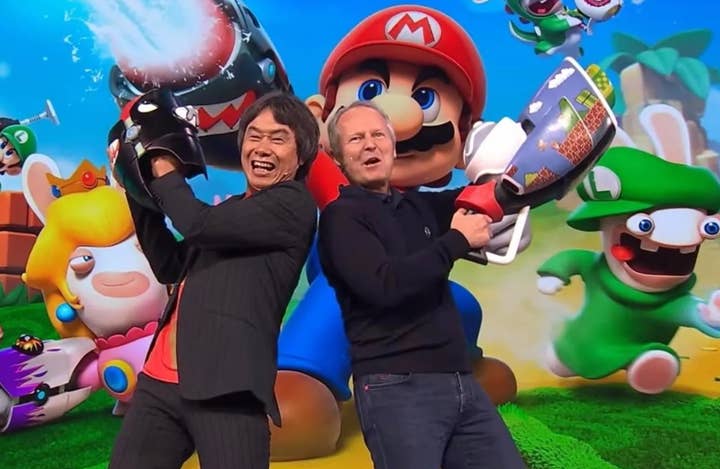
Yet for all the famous faces, Winkler says it was the human moments that made E3 special. That iconic Mario + Rabbids pose may have been the picture of the show, but it was the footage of the game's creative director, Davide Soliani, in tears that resonated the most.
"That's the cool thing about events; you can show the human side of the work that we do. I could see in rehearsals that Davide was getting emotional, and I thought 'Maybe we should get a camera moment ready for that'. Because it is important. It humanises us as an industry. It's Davide, who has been a Nintendo fan since he was a kid, and now his idol is on stage giving him props… I would cry, too."
Giant booths, 87-piece orchestras, and Cirque du Soleil
Beyond the celebrities there were the production values. E3 booths were frequently extravagant. Personal favourites of mine include Capcom's recreation of the Resident Evil 7 house, Bethesda's Fallout 76 vault experience, and the absolutely huge Mafia 3 booth, which brought New Orleans to the show floor.
"Game companies have always been extremely competitive, so this manifested itself in the extravagance of the booths," Dolaher says. "With that said, I didn't anticipate having to facilitate things like having Marines rappel down the outside of South and West Halls of LACC, building a full-scale boxing ring in one of the halls, constructing a castle on the show floor, and so much more."
Nintendo's booth was almost always a destination. It was routinely more like something you'd expect to see at Disneyland than a trade show, with its thick plush carpet and impressive set designs. During the Switch era alone, we had recreations of Hyrule, New Donk City (from Super Mario Odyssey) and even Luigi's Mansion.
"It was hard work and expensive, and the person who led it [Don James], led it from the very first show to the last," Kaplan shares. "He's still at Nintendo. I couldn't imagine a more passionate person leading that. For Nintendo, it was just a great creative endeavour. What do we want it to feel like? What's the theme? And we really wanted to build that out so the experience could be extremely satisfying."
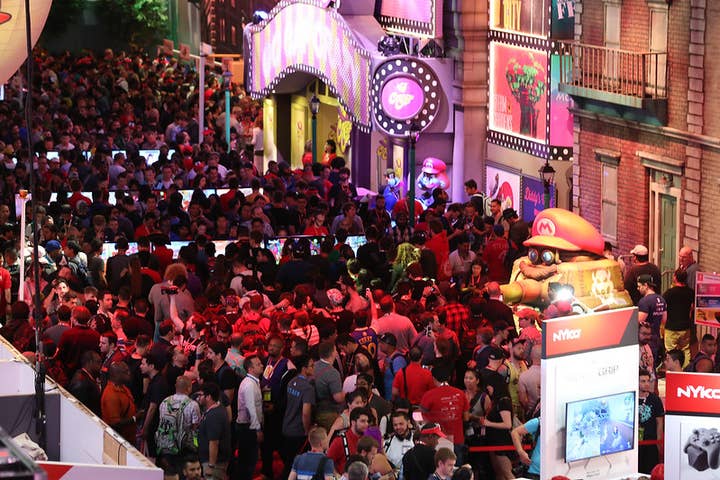
The extravagance and expense wasn’t just confined to the E3 show floor. Layden recalls Sony's theatrical E3 2016 press conference, complete with live orchestra.
"They'd torn down the sports arena where we had been doing E3 for ten years, so we went to the Shrine Auditorium," he says. "So many people go there and try to turn it into a modern event hall, but it can't be. It was built in 1927. So we said 'Let's embrace it'. We had the full maroon, velvet scrim that dropped behind the stage. We had an orchestra pit. So we went old school. I had Bear McCreary conducting an orchestra right in front of me. I hit my mark, I make my pivot, Bear pulls his arms up, I nod my head and Bear suspends the orchestra. There is no feeling in the world like walking out on stage to an 87-piece orchestra. There's nothing like that. It was fucking amazing.
"That will be my lasting memory of E3. That, and getting pushed out of the food line by Macy Gray at the PlayStation party. I was standing too long in front of the mash potato, and Macy needed her potatoes."

If that sounds expensive, consider Microsoft's E3 2010 showcase for Kinect.
"In one of the planning meetings, I kept on saying that we needed to do something different and more unique than just a press conference," remembers Matthews. "I said 'It's about movement and motion. We need to do something like Cirque Du Soleil would do'. And I remember walking out of that meeting, stopping and looking at my head of events and saying 'Heck, we're Xbox, why don't we just call Cirque Du Soleil?'
"We gave them a call the next day. We flew out to see them the next week. We were up in Montreal. We told them the story of Kinect and the vision, and they flew down two weeks later. We were in a conference room at Microsoft, and the creative director of Cirque Du Soleil comes in with several of his staff. He hits play on a sound system, and this crazy surreal music starts to play. They turn down the lights, they light these twinkling lights around the room, and then he starts with 'It's beyond the beginning of time', and he throws a bucket of sand onto the conference table 'And the people of the world are primitive'.
"And that was our show. I stood in that arena after we did it live, and I called my wife and said: 'This is one of those moments in your career that you never thought would happen, but I am always going to remember'."
The 'live' element of E3 was often a terrifying experience. During the Cirque Du Soleil rehearsal, Matthews remembered how the rotating stage wasn't moving at the right time, the screens were out-of-sync, the scoreboards in the arena randomly turned on at one point… but that was the only rehearsal. The next time it was performed, it was live (and thankfully, it went 'flawlessly').
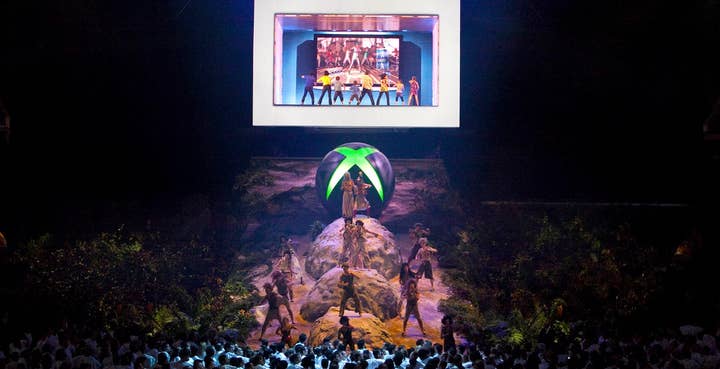
Outside of performances, the other challenge was making sure the game demos didn't break.
"Shit goes wrong all the time," Moore says. "We would always ghost ride behind a game… so you'd have another console running the demo in parallel. I remember Gears of War crashed… but it was almost unknown to the audience because we clicked the input and the ghost rider took over. A few people might have gone 'What just happened?', but not many. We were a pretty well-oiled machine in all my three iterations of Sega, Xbox and EA."
Matthews adds: "I can't tell you how many back-ups upon back-up systems that we would run to make those shows go."
Unfortunately, no amount of back-up systems could prepare for human error.
"One time, I played Rock Band live with Harmonix, and I accidentally paused the game, and I think a million people laughed at me," Moore recalls fondly. "In rehearsal it was fine, but when we went live I realised there was a slight lag from where I was looking at the screen and bizarrely I… I think of that and I smile, but also feel a bit of horror."
EA, Sony, and Microsoft leave the LACC
E3 was expensive and a huge amount of work. The whole industry was geared around it. Companies held back announcements for that week, developers would build dedicated game demos, and there were teams working on it all year long.
"We basically produced the equivalent of the Grammys every year with the main press conference and show," Matthews says. "There was a big part of my team where that was what they did for the best part of a year."
Layden adds: "The planning was immense, which is why taking E3 out of the schedule has opened up thousands of man hours across the industry. Quite often when you build demo code for E3, it's not game code, it's a discrete piece of work that you create just for that show. And then you throw it away and you go back to working on the main game.
"We basically produced the equivalent of the Grammys every year with the main press conference and show"
Rob Matthews, former Nintendo and Xbox exec
"The people who organise our E3 show are the people who organise shows for Disney and the networks… TV producer people, basically. It's a high-wire act, and it can be incredibly frightening."
And the financial cost was enormous. "It was in the tens of millions of dollars," Moore says. "Whether that's building out the booth or attending… in those days we were taking 300, 400, 500 people to E3.
"But also you had to look at the productivity cost of taking people away from their day jobs for months to work on booth development, marketing tools, digital assets… everything."
The cost of E3, whether we're talking time or money, was proving harder to justify. E3 was a media and retail event, but the role of retail was becoming smaller in the face of digital distribution. Plus, as the industry evolved, June was often too late to be selling to retailers anyway.
"You had to sell Christmas business in February," Layden explains. "You couldn't wait until June. So by the time E3 came around, you're not selling anything anymore."
Then there was the role of the media. Although still important, publishers were increasingly going direct to consumers with their messaging. Nintendo stopped doing its press conference in 2013 in favour of a pre-recorded video aimed at fans.
"Direct-to-consumer became a bit of the downfall of E3," explains Moore. "Folks in the media became a little less important."
Layden agrees: "For the big companies, it just became a peacocking event. It also wasn't so much about press anymore, because everyone was breaking embargoes anyway, and the press was publishing 24 hours a day… by 2015, E3 had really lost its meaning as a trade show because no trade was really happening."
EA was the first major company to leave E3 in 2016. The publisher was eager to involve fans in its event and after failing to convince the ESA to allow that to happen, it held its own event – EA Play – in the same city just before E3 opened its door.
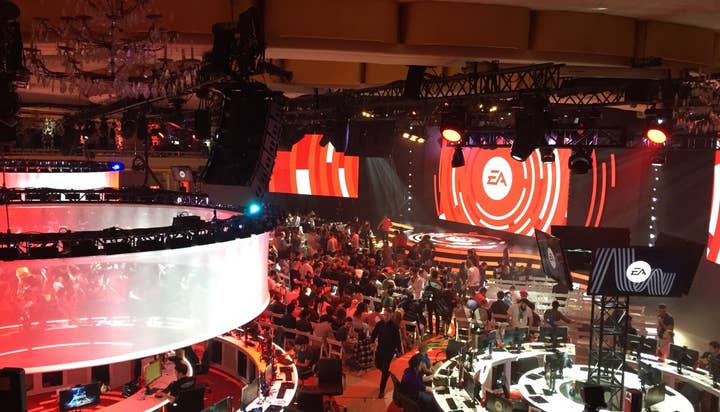
"We decided to just do our own," Moore says. "You rent a hotel, and a big space, and then you see how it goes. Once we pulled out, the belief was that the other guys would, too. Maybe it would be a death by 1,000 cuts. I lived through this in my previous life. I watched Nike, Adidas and Reebok pull out of the Super Show in Atlanta, and the thing collapsed completely. It took a little longer with E3, but ultimately, as the industry changed, the need for E3 waned. And from the perspective of spending that kind of money, and not speaking to gamers directly… it seemed kind of reductive to us."
E3 was strict with its exhibitors. If a company dropped out one year, it risked losing its preferred spot on the show floor. That's why one year Capcom took an entire booth primarily to promote its DuckTales remaster, and why Take-Two built a whole booth for invite-only meetings. They wanted to hold their space for the following year.
There was very little flexibility with E3 rules. If you wanted to do something differently, such as what EA wanted to do, then tough.
"You have to apply the rules evenly across the board with everyone, everything down to every last detail in the contracts," Dolaher says. "You'll get someone come up and say 'We are not going to sign it this year, we don't like this clause'. And then we'll say 'Sorry, then you're out. We want you in the show, but we can't be arbitrary and capricious on all of the rules'. It's hard to say no when they're the ones signing your cheque, but it has to be a level playing field for everyone."
The industry was at odds with what they wanted E3 to be. Some publishers wanted a pure B2B show, while others wanted to allow the fans in.
The attempted solution in 2016 was to add something called E3 Live at the neighbouring LA Live complex. But the free event was announced late and the results were poor.
"I have a lot of grey hairs from that," says Dolaher.
"We only had six weeks, because the ESA didn't like the logo and kept holding things up. If we had a full year, we could have populated the whole of LA Live, so the whole campus would have felt like 'Okay, this is where E3 is, but the B2B bit is in the building'. There were so many ways to do it, and we tried a lot of them, but you have to have that industry consensus, because that's where it starts to fall apart."
In the end, the organisers started selling consumer tickets to the main E3 show, with 15,000 going on sale in 2017. But E3 simply wasn't built for gamers, and the next major exit from the show was Sony in 2019.
"E3 couldn't adapt," Layden says. "It was like 'Well, we'll sell 15,000 consumer tickets.' And I remember fighting with the ESA Board about that. I said 'Pick a lane, you're a consumer show or a trade show, you can't be both.' The physical design of a consumer show is different to a trade show. A trade show you're trying to make it like Ikea, where people can never get out. But with a consumer show, you design it for throughput.
"When E3 started inviting consumers in, and they're waiting for four hours to play Breath of the Wild… that's not a good experience."
Sony, which had been a key part of E3 since its inception, couldn't justify the show anymore.
"We promised the ESA that we wouldn't set up a competitive event. They could have their week"
Shawn Layden, former PlayStation US CEO
"The press already has your stories, so trying to hold something back for a surprise announcement was getting harder and harder," Layden says. "And then you looked at the cost. The press conference was a tonne of money, then there was the booth on the show floor, and then you're paying drinks, hotels, flights and martinis for 400 people.
"Going into 2019, we looked at it and felt that June was an arbitrary date, we don't have anything in development to go into that window and tell a good story, and if you're doing E3… from January 1 until E3 is over, your dev teams are locked in making demos, and your marketing department is locked in getting the hype machine running. By not doing E3, it gave us three months back into the calendar.
"We promised the ESA that we wouldn't set up a competitive event. We won't do any pressers, or state of the nation addresses… they could have their week."
Another blow was Microsoft's decision to move its booth off the E3 show floor and into the theatre next door, which the company owned at the time.
"Letting Microsoft go there… that is something in the earlier days we would never have done," Dolaher says. "We wouldn't have given them free space, but we would have done what we had to to keep them on the show floor. They own the theater, so what are you going to do? Letting them go over there, letting EA leave and go across town… that was a slow painful death."
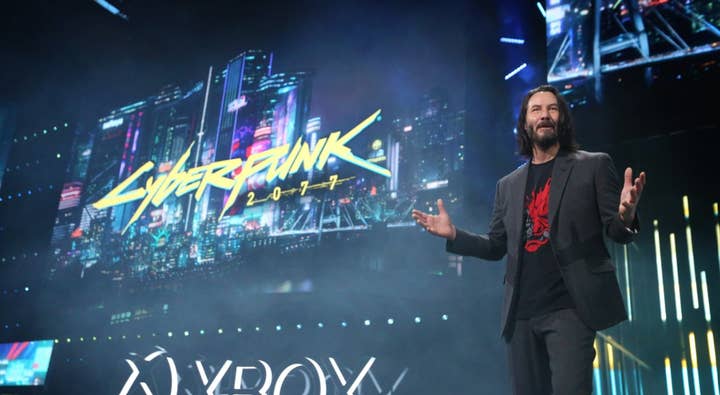
Yet Matthews has a different perspective on the E3 exodus. Microsoft was still eager to support E3. Indeed, tickets to the E3 show floor also got you into Microsoft's event, too. Companies wanted different things from the show, and agreement was hard to come by, but ultimately they were all – PlayStation aside – still doing events during that same period.
"It was an example of the industry's commitment to E3, and commitment to that period in time to still come together as an industry," Matthews says.
"We didn't need to do [our event] that week. We could have done it in the Microsoft Theater at any time during the year. But we committed to doing it. Yeah, we were going to do it a little differently. It was evolution, but a commitment to showing up together and doing something bigger than ourselves."
The death of E3
By 2019, E3 was in trouble. The ESA parted company with Dolaher after that year to take the event in-house, but then the pandemic hit. E3 2020 was cancelled. There was a 2021 digital event, but it proved costly and it wasn't repeated in 2022.
"COVID was the big proof point," Layden says. "COVID shut down E3 and the video games industry grew revenue. It didn't have the biggest video game show, but it still got bigger as a business. Ask any CFO at any big games company if they want to drop $10 – $15 million that they've not had to spend for three years on E3… and they'll say 'Are you crazy? Look at all that money we saved, and we still grew'."
"The industry is in a far better place now because of E3."
Peter Moore, former Sega, Xbox and EA exec
The ESA decided a new direction was needed, and turned to ReedPop – organisers of New York Comic-Con and the PAX video game shows (and, at the time, owners of GamesIndustry.biz) – to help find it. It was going to be a tight turnaround. By the time ReedPop was brought in, there was less than a year to build a team, speak to the industry and put together a show.
"When ReedPop got involved the whole attitude was not just how do we bring it back, but also how do we evolve it to what's needed," says Guy Blomberg, who was brought in to work on the event. "That was exciting to almost everyone I spoke to."
However, the team encountered an industry divided. "Some wanted a pure consumer show, others just wanted B2B," Blomberg says. "Some only cared about digital, others on the fan experience. Some folks only wanted a repeat of what was before, others wanted to blow it all up and start over. Everyone wanted something different, it was incredibly difficult to navigate, and there was an equal amount of passion and anger toward the brand – it was honestly exhausting."
ReedPop developed a new format, but not everyone was convinced, and some of those who were interested simply didn't have the line-up to justify an E3 booth. In the end, the 2023 event never happened and ReedPop parted ways with the ESA.
Six months later, E3 was pronounced dead.
The industry reaction online was one of sadness. Winkler described working on E3 as "a dream come true", and for many, simply going to the show was aspirational.
"What kills me… we did a lot of work with Make-A-Wish kids, and we would fly them in, we once had up to 30," Dolaher says. "And we would get them chaperones in the booths, and Microsoft would give them a brand new console… Parents still write to me and say thank you, and it's just soul crushing. It's all those kids wanted. There was no other show like it."
Matthews opines: "E3 was special. You never knew what was going to happen. There was always something that came out of nowhere, and that made it fun and interesting and nerve-wracking. That is the part I am sad about the most, because it is more traditional now. It's like every other industry. We all get our news out the same way. E3 was uniquely video games."
For Layden, he believes there is still a need for something in the old E3 window. But it would need to be for fans, and not take place in Downtown LA.
"I have had outreaches to me from larger concerns to try and figure out what it would take to resuscitate E3," Layden reveals.
"If you could make it a full-on consumer event… And Downtown LA is a terrible place for the show. There's not enough affordable hotels. The venue needs to move, but still needs to stay in California somewhere.
"Gamescom in Europe, Tokyo Games Show in Asia… we have PAX East and West in the US, but they're still minor league shows. You could do a full-on consumer show if you have the right leadership and the right amount of money to do it."
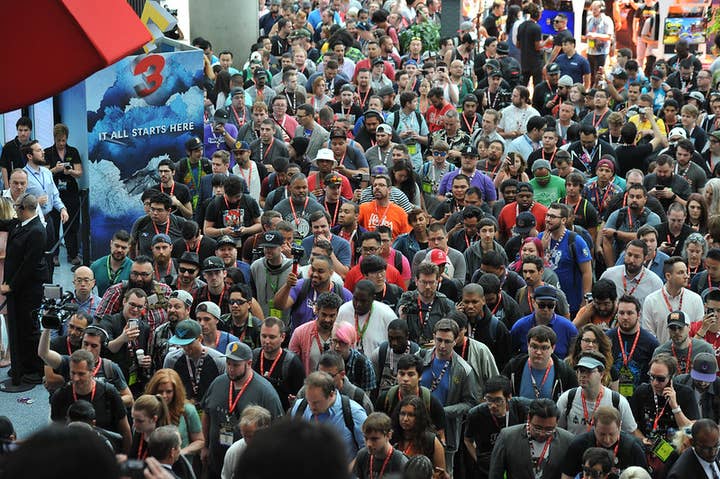
Indeed, Winkler points to the fact that there are still things happening during the old 'E3 week' as proof that there's still a demand for a physical presence in LA. This week, Xbox, Ubisoft and IGN are holding physical events, while Summer Games Fest's Play Days showcase features titles from EA, PlayStation, Netflix, Amazon, Tencent, Bandai Namco, Capcom and numerous other major companies. It isn't E3. It isn't the big noisy show that echoed around the world. But it is something.
"Most publishers are going to be at Summer Games Fest in one shape or form," Winker observes. "So although they might not be spending the big cash, they still see the value in these in-person face-to-face moments where they can interact with peers and the community. As an events guy… that gives me hope."
Whatever happens next, it's worth considering E3's legacy and what it achieved.
To return to where we started, it was about respect. In 1995, the games industry was being ignored by the media, treated with disdain by politicians and dismissed by Hollywood. Now, video games is the biggest entertainment medium on earth, politicians are supporting it with tax breaks, mainstream publications cover games regularly and Hollywood is awash with games IP. 30 years ago, Sega was practically thrown out of the office of the Motion Pictures Association, whereas today Sonic is a blockbuster movie franchise.
In 1995, the games industry was desperate for attention and respect. In 2024, it now has it, and E3 was part of how that was achieved.
"E3 certainly served its purpose in terms of relevancy and respect," Moore concludes. "There was a time when we were just being ripped for being a waste of time, all the social ills were being blamed on gaming, and it was seen as triviality and a phase that primarily young boys went through until they got serious about life. That's not the case anymore.
"The industry is in a far better place now because of E3."
